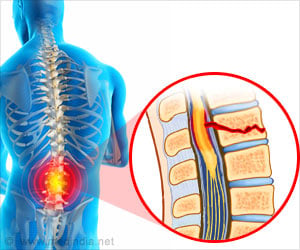- Moebius Syndrome - (https://ghr.nlm.nih.gov/condition/moebius-syndrome)
- Picciolini O, Porro M, Cattaneo E, Castelletti S, Masera G, Mosca F, Bedeschi MF. Moebius syndrome: clinical features, diagnosis, management and early intervention. Italian Journal of Pediatrics 2016; 42:56 - ( https://doi.org/10.1186/s13052-016-0256-5)
- Magnifico M, Cassi D, Kasa I, Di Blasio M, Di Blasio A, Gandolfini M. Pre- and Postsurgical Orthodontics in Patients with Moebius Syndrome. Case Reports in Dentistry 2017, Article ID 1484065, - ( https://doi.org/10.1155/2017/1484065)
What is Moebius Syndrome?
Moebius syndrome is a condition that affects the development of the cranial nerves VI and VII, either on one or both the sides of the head. It is named after the neurologist P. J. Moebius who studied the condition in 1888. Moebius syndrome is estimated to affect around 1 in 50,000 to 1 in 500,000 newborns. Both male and female children are equally affected.
Anatomy of the Cranial Nerves
There are twelve pairs of cranial nerves, among which the first two arise from the cerebrum, while the remaining arise from the brainstem. The nerves are either sensory, that is, they carry sensations to the brain; motor, that is, they control muscle movements; or mixed, which contain both sensory and motor nerves. They supply to the head and neck region, except the tenth (vagus) nerve and a few fibers of the XIth nerve, which also supply the chest and the abdomen.
The VI cranial nerve is a motor nerve that innervates the lateral rectus, the muscle that causes the eyeball to move laterally, that is, towards the outer corners of the eyes. The VII cranial nerve is a mixed nerve i.e. it carries both sensory as well as motor impulses. The sensory part carries taste sensations from the outer 2/3rd of the tongue, and soft and hard palate which form the roof of the mouth, to the brain. The motor part of the facial nerve controls the muscles of facial expression. When the facial muscles contract, various emotions are apparent on the face like smiling, frowning, or wrinkling the forehead. In addition, the facial nerve also carries parasympathetic nerve fibers that control the secretion of the salivary and mucous glands of the mouth and nose, and the tear secretion of the lacrimal gland.
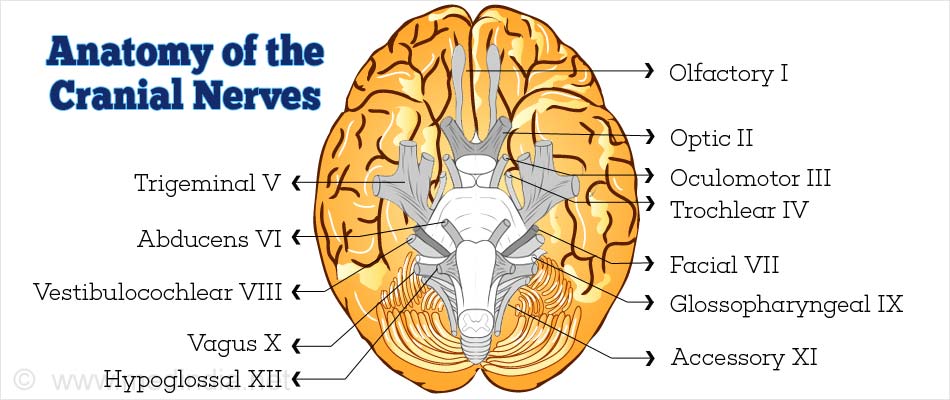
Based on the extent of the disease, Moebius syndrome can be classified as:
- Moebius Syndrome: Here, the VII and VI nerve are completely paralyzed on both sides
- Incomplete Moebius Syndrome: Here, some movement is present on one side of the face
- Moebius-like forms: Here, one side of the face is paralyzed, but other cranial nerves are also involved
What are the Causes of Moebius Syndrome?
The exact cause of Moebius syndrome is not known. Genetic and environmental factors have been implicated.
- Genetic factors: Changes in the chromosomes 3, 10, or 13 may be responsible for Moebius syndrome. A definite family history, however, cannot be elicited in most cases.
- Environmental factors: Environmental factors like certain medications or drugs of abuse taken during pregnancy may result in a baby with Moebius syndrome. These may cause changes in blood flow to the brainstem, from where the cranial nerves arise, thereby affecting the development of the nerves. They may also cause an embryonal brain defect, resulting in the condition.
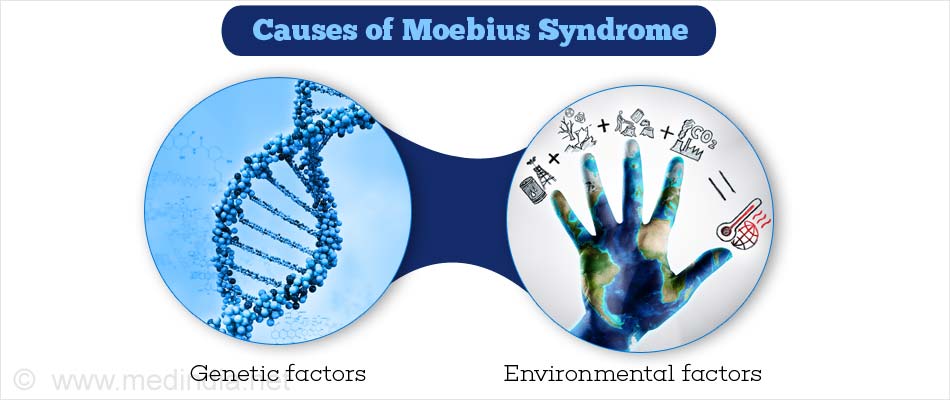
What are the Symptoms and Signs of Moebius Syndrome?
The features of Moebius syndrome are present since the birth. They include the following:
Facial paresis or paralysis: Weakness or paralysis of the facial muscles is the primary feature of Moebius syndrome. As a result, the baby:
- Has difficulties with suckling and may have to be fed with feeding tubes or with a special feeding bottle. Drooling at the angles of the mouth may be noted. The mouth usually remains open. Speech is affected.
- Lacks facial expressions. The baby cannot smile or frown, resulting in a mask-like face.
These two features could interfere with the mother-baby bonding in the initial period after birth.
The muscles of the eyelids and around the eyes are also affected. Older children cannot raise their eyebrows. Incomplete closure of the eyelids could result in the eyes going dry and the cornea getting damaged due to excessive exposure.
The lack of facial expressions could interfere with social communication.
Problems with eye movements: Due to the paralysis of the lateral rectus muscle, the eye cannot turn outward. As a result, the child has to move the head while reading or following movements of objects. Squint may be present. The vertical movements of the eyes are not affected.
Involvement of other cranial nerves: Features due to involvement of other cranial nerves may be present which could include the 5th, 8 th, 9 th, 10 th, 11 th, and/or the 12 th nerves
Intelligence is usually normal. Though developmental delays may be noted around 1 year of age, the children tend to catch up by the time they are around 5 years of age.
Associated congenital abnormalities
Patients with Moebius syndrome often suffer from congenital malformations. These may include:
- Musculoskeletal abnormalities: Bony and muscle abnormalities in the hands and feet may include clubfoot or webbing of fingers or short fingers or even a split hand. Clubfoot, where the feet turn inwards at the ankles, is among the most common bony deformities. The chest and breast of one side of the body may be underdeveloped. The muscle tone may be weak.
- Oral and facial anomalies: The child may have a small chin, a condition called micrognathia. The teeth may be missing or misaligned. The mouth may be small with a short or unusually shaped tongue. The palate may be high or arched or with a cleft. These features may add to the speech and feeding problems. The external ear may be absent or underdeveloped. Hearing loss may occur if the VIIIth nerve is affected.
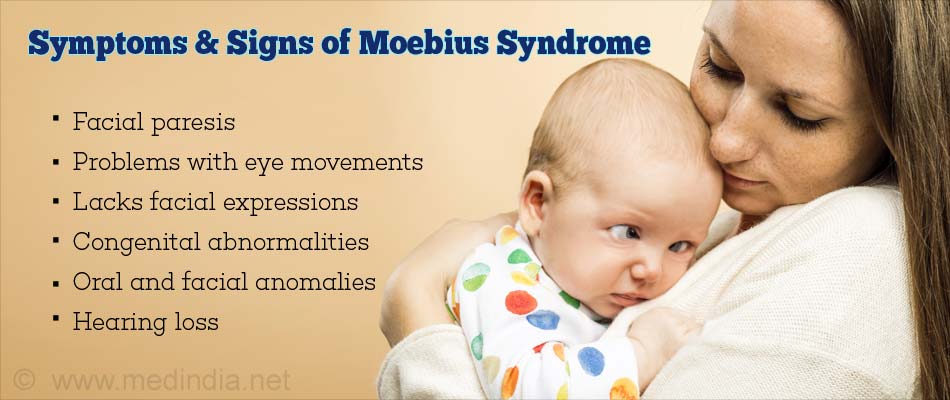
How do you Diagnose Moebius Syndrome?
The diagnosis of Moebius syndrome is based on the clinical features. Tests that may be advised include the following:
Imaging tests: CT scan and MRI may be carried out to rule out any other causes of the symptoms. They may also detect calcifications in the region of the nucleus of the VIth cranial nerve. The brainstem may be underdeveloped and the VIth and VIIth nerves will be either underdeveloped or absent. These tests are, however, not necessary for the diagnosis of Moebius syndrome.
How do you Treat Moebius Syndrome?
Early diagnosis and rehabilitation of the child are necessary to ensure that the child does not suffer from the long-term consequences of Moebius syndrome. The rehabilitation process should be modified as the child grows in line with the improvements showed by the child.
- Tube feeding or feeding with special bottle may be necessary in the early days. Since the child cannot communicate feelings through facial expressions and the mother cannot breast-feed the child, the rehabilitation process should also address the mother-child relationship
- Lubricant drops should be put into the eyes frequently. Ulcerations of the cornea are medically treated. Surgical treatment for squint is usually delayed, since the squint could improve on its own
- Physiotherapy and speech therapy are useful to help the patients overcome their disabilities
- Occupational therapy may be required for people with problems with their hands and fingers. Some may require prostheses for their orthopedic problems
Psychotherapy may be required to prevent the emotional disturbances associated with the condition. Parents should also be provided adequate support following the diagnosis and during rehabilitation
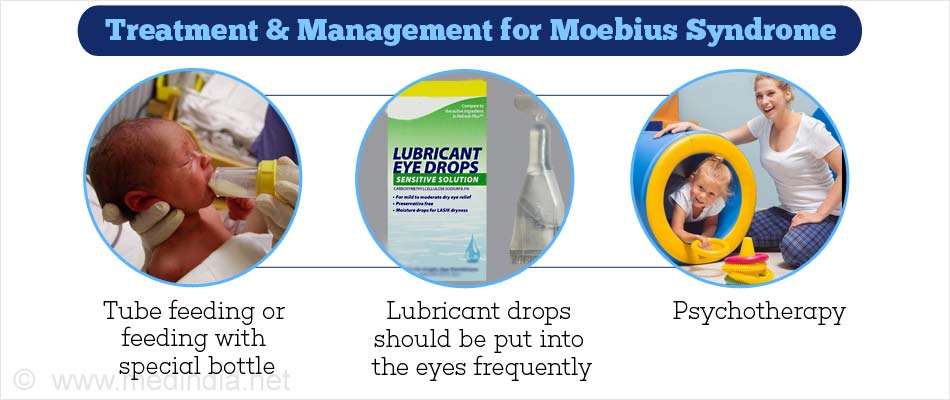
Surgical Treatments
Severe cases may require surgery. Surgical treatments to manage the facial paralysis include the following:
- "The smile operation”, where a muscle from the thigh called the gracilis is transferred to the face and is connected to the nerves supplying the masseter muscle of the face, so that it can function. This surgery is currently considered the best current option for the condition
- The temporalis tendon transfer, where the temporalis muscle of the face is transferred to the corners of the mouth, and the “cross-facial nerve graft” which is done in cases of one-sided paralysis are other options
Other deformities like the limb and jaw deformities may also require surgical treatment.
More severe cases may require surgery in the form of free-muscle transplant innervated with motor nerves.


